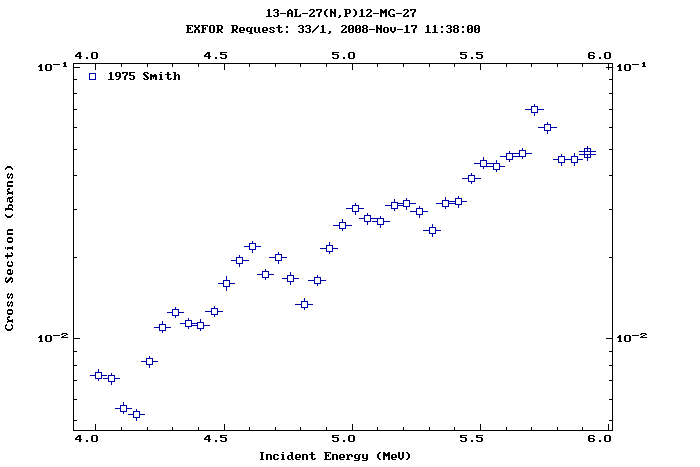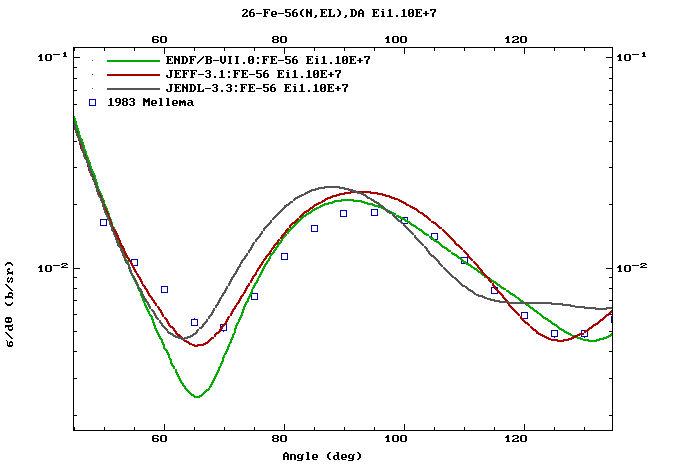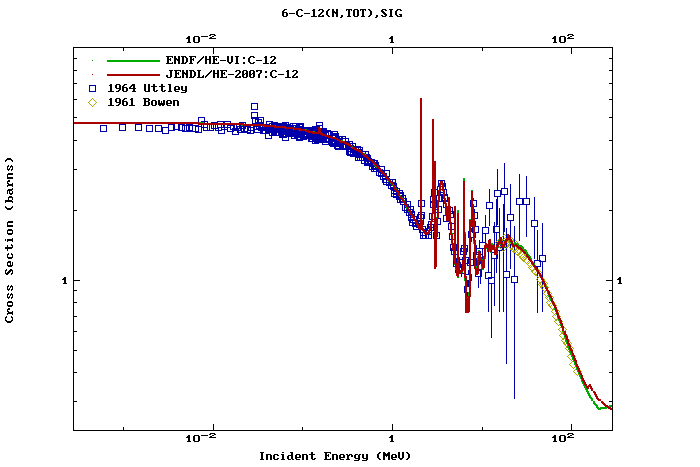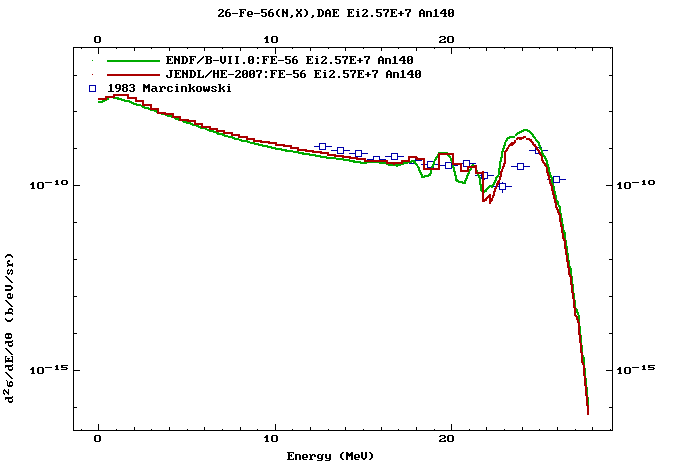EXFOR Basics
III. User Output Formats
This chapter describes the various output formats available to users who retrieve EXFOR data. Not all formats mentioned here are necessarily available from all EXFOR sites, and some data centres may offer additional formats not described here.
- EXFOR Exchange format: available from all EXFOR sites. Described in general in Chapter I and in more detail in Chapter II.
- EXFOR+ format: Interpreted EXFOR. User friendly output for human reader. See examples in Chapter I. Will be refined further to give expanded output for more keywords.
- Computational format C4: This is the format mainly in use for plotting and processing EXFOR data. See following pages for a description
Merely as an illustration, examples of other user output formats are shown also, on pages 54 ff. Since these are not part of the NRDC exchange agreements and are not necessarily available from all EXFOR centres, they are not described in detail. The examples included here are:
- Tabular formats:
- R33 format (for Ion Beam Analysis community)
- Extended C4 computational format
- Bibliographic output
- Plots
Computational Format C4
This is the computational format mainly in use for plotting and processing of EXFOR data, which is available from IAEA-NDS and some of the other data centres. Its main features are described below.
(The following is an edited extract from: Dermott E. Cullen and Andrej Trkov, "Program X4TOC4", report IAEA-NDS-80, Rev.1, March 2001)
The C4 computation format is designed to present experimental data in a fixed set of units and column order. By starting from data in the EXFOR format and translating data to the computation format it is possible to combine the advantages of the improved reliability of the data coded in the EXFOR format with the advantages of a fixed unit and column order format for use in subsequent applications.
In addition, the computation format is point oriented (as opposed to the table oriented EXFOR format). Each line of the computation format represents a single data point. This makes it possible to sort data in the computation format into any desired order for use in application, e.g., sort 26-Fe-26 (n,2n) data from a number of measurements together into energy order to simplify comparisons.
Relationship to ENDF
It is assumed that one of the major uses of this format will be to prepare data for subsequent use in evaluation and/or to compare available evaluated and experimental data. As such the computation format has been designed to allow data to be reduced to a form in which data are classified in a manner similar to ENDF data [7] .
In particular the EXFOR classification of data by the EXFOR keyword REACTION is replaced by classifying the data by (1) projectile, (2) target - ZA, (3) type of data (ENDF MF number), (4) reaction (ENDF MT number). In addition the standard units used by the translation program were selected to be the same as the units used by ENDF (e.g., eV, barns, etc.).
The result of putting data into the computation format is that it is easy to decide if the data is comparable to evaluated data (e.g. same ZA, MF, MT) and once it is decided that data is comparable, evaluation and/or comparison is simplified because the data is in the same units as ENDF (e.g., eV vs. barns).
Extensions of ENDF conventions
For all types of data which are physically comparable to data which can be included in the ENDF data, C4 uses the ENDF definitions of (1) type of data (ENDF MF number), (2) reaction (ENDF MT number). For example all cross sections are represented by MF=3, angular distributions by MF=4, energy distributions by MF=5 and double differential distributions by MF=6. Similarly for simple reactions such as total, elastic etc., the data are translated into corresponding MT=1,2, etc., respectively.
Since many types of data which appear in EXFOR do not have a one to one correspondence to data which appear in ENDF, the ENDF classification of type of data (MF) and reaction (MT) have been extended to allow additional types of data and reactions to be translated (e.g., define MF numbers for ratios, define MT numbers for (n,np)+(n,na) reactions).
The ENDF MF is a 2 digit number and the MT is a 3 digit number. In the computation format MF has been extended to 3 digits and the MT has been expanded to 4 digits. These extensions allow the user the flexibility to translate virtually any EXFOR data to a fixed set of units and column order for subsequent use in applications.
Since EXFOR contains a very large variety of data types, not all EXFOR data can be automatically translated into C4 format. Tools for handling such cases, i.e. for translating additional data types into C4 format on a case-to-case basis, are available in the translation program X4TOC4 which is distributed as part of the ENDVER program package [8] . . This program allows the user also to change other parameters of the translation to C4. The following pages describe the default options the user will get when retrieving C4 data directly.
Computation format units
All EXFOR units are converted to ENDF units:
| eV | = energy |
| barns | = cross section |
| steradians | = solid angle |
| seconds | = time |
| kelvin | = temperature |
Computation format fields
The computation format uses a classification system and units which are compatible with ENDF. Data is classified by
- ZA of projectile,
- ZA of target,
- metastable state of target,
- MF - type of data,
- MT - reaction,
- metastable state of residual nucleus.
To identify the source of the data the first author and year and the EXFOR accession and sub-accession number are included in the format. In addition, fields are assigned to define the status of the EXFOR data (e.g., S = superseded), whether data is in the laboratory or center-of-mass frame of reference, and the physical significance of the last 2 output fields (LVL = level energy, HL = half-life). Finally the format includes 8 fields in which the output data are contained (e.g., incident energy, data, cosine, uncertainties, etc.)
| Columns | Description |
|---|---|
| 1- 5 | Projectile ZA (e.g. neutron =1, proton =1001) |
| (defined by reaction dictionary). | |
| 6- 11 | Target ZA (e.g. 26-Fe-56 = 26056) |
| (defined by EXFOR reaction). | |
| 12 | Target metastable state (e.g. 26-FE-56m = M) |
| (defined by EXFOR reaction). | |
| 13- 15 | MF (ENDF conventions, plus additions) |
| (defined by reaction dictionary). | |
| 16- 19 | MT (ENDF conventions, plus additions) |
| (defined by reaction dictionary). | |
| 20 | Product metastable state (e.g. 26-FE-56M = M) |
| (defined by EXFOR reaction). | |
| 21 | EXFOR status |
| (defined by EXFOR keyword status). | |
| 22 | Center-of-mass flag (C=center-of-mass, blank=lab) |
| (defined by EXFOR title dictionary). | |
| 23- 94 | 8 data fields (each in E9.3 format defined below) |
| (defined by MF and title dictionary). | |
| 95- 97 | Identification of data fields 7 and 8 |
| (e.g., LVL=level, HL=half-life, etc.). | |
| 98-122 | Reference (first author and year) |
| (defined by EXFOR keywords title and reference). | |
| 123-127 | EXFOR accession number |
| (defined by EXFOR format). | |
| 128-130 | EXFOR sub-accession number |
| (defined by EXFOR format). | |
| 131 | Multi-dimension table flag (EXFOR pointer) |
| (defined by EXFOR keyword reaction or common fields). |
Definition of 8 computation format data fields
The general definitions of the 8 computation format data fields are:
| Data field | Definition |
|---|---|
| 1 | Projectile incident energy |
| 2 | Projectile incident energy uncertainty |
| 3 | Data, e.g., cross section, angular distribution, etc. |
| 4 | Data uncertainty |
| 5 | Cosine or Legendre order |
| 6 | Cosine uncertainty |
| 7 | Identified by columns 95-97 (e.g., level energy, half-life) |
| 8 | Identified by columns 95-97 (e.g., level energy, uncertainty) |
The physical significance of each field is defined by the assigned MF number. For example, for MF =3 (cross sections), columns 1 and 2 contain the incident projectile energy and its uncertainty in eV, respectively and columns 3 - 4 contain the cross section and its uncertainty in barns, respectively and columns 7 and 8 may contain a level energy and its uncertainty in eV or a half-life and its uncertainty in seconds.
Special conventions
The above conventions are appropriate for most types of data in the ENDF system. In order to process additional types of data the following special conventions have been adopted:
- Cross section ratios (MF = 203)
- Field 5 = MT of denominator.
- Field 6 = ZA of denominator.
- Resonance integrals (MF = 213)
- Field 1 = lower energy limit.
- Field 2 = upper energy limit.
- Spectrum averages (MF = 223)
- Field 1 = lower energy limit.
- Field 2 = upper energy limit.
- Fission yield data (MF = 801)
- Field 5 = charge of fission fragment.
- Field 6 = mass of fission fragment.
- Production data (MT = 9000 - 9999)
- Field 6 = ZA of product.
Metastable states
The computation format allows the metastable state of the target and residual nucleus to be identified. For ratio data, the Metastable state of both numerator and denominator of the ratio may be defined.
The metastable state of the target is identified in column 12 and the metastable state of the residual nuclues in column 20. For ratio data the metastable state of the denominator target and residual nucleus are identified by output the denominator ZA and MT in the form ZA.M and MT.M (e.g., 26056.9 and 102.1). Columns 12 and 20 could contain characters such as M, but to maintain the eight output fields in strictly numerical form the denominator ZA.M and MT.M will be output in numerical form. The possible characters that may appear in columns 12 or 20 and their numerical equivalents used with ratio denominator ZA and MT include:
| Definition | Column 12 or 20 | Equivalent |
|---|---|---|
| ground | G | 0 |
| m1 | 1 | 1 |
| m2 | 2 | 2 |
| m3 | 3 | 3 |
| m4 | 4 | 4 |
| m5 | 5 | 5 |
| unknown | ? | 6 |
| m | M | 7 |
| more than 1 | + | 8 |
| all or total | T | 9 |
| all or total | blank | 9 |
By convention, if an EXFOR reaction does not specify a Metastable state the state is defined in the computation format to be..ALL.. (i.e., blank in column 12 or 20, 9 in ratio ZA or MT).
For example, for a ratio if the ZA.m and MT.m are output as 26056.9 and 102.1, respectively the ratio denominator target is 26-Fe-56 (all) and the reaction is capture (MT=102) leaving the residual nucleus in the m1 state.
EXFOR Status
Column 21 of each computation format record may contain blank (status not specified) or one of the following characters:
| Column 21 | Definition |
|---|---|
| U | Un-normalized (indicated by unit translation dictionary) |
| This condition has priority over the EXFOR status and is used to indicate that the data is not in standard output units). | |
| A | Approved by author |
| C | Correlated |
| D | Dependent |
| O | Outdated |
| P | Preliminary |
| R | Re-normalized |
| S | Superseded |
If data has any other EXFOR status (e.g., translated from SCISRS), it will be ignored and the status field will be output as blank.
- C4 Example 1: 178Hf(n,p) cross section
- C4 Example 2: Partial differential cross section for 56Fe(n,n')
Examples of other output formats
Example: T4 format
Simple tabulated cross sections with short bibliography, for single datasets
T4 Example : 178Hf(n,p) cross section (EXFOR #22311.011)
Example: TAB format
Computational format introduced in the 1980s for the CSISRS/EXFOR system in use at NNDC (USA), still available for backwards compatibility. Separate output of tables, reference (XREF) and BIB files.
TAB format Example: Table / XREF / BIB
Example: R33 format
This format was developed for the ion beam analysis (IBA) community and is used e.g. in the IBANDL database. For the data types relevant for IBA (mainly charged-particle induced differential cross sections at fixed angles dependent on projectile energy) it is available as EXFOR output format.
R33 Example : 6Li(3He,p)8Be cross section (EXFOR #A1495.003)
Plotting option from R33 output
Example: Extended C4 format
Computational format (C4) output with explanatory text lines (labelled with #) added for better readability.
Extended C4 Example : 6Li(3He,p)8Be cross section (EXFOR #22311.011)
Example: Bibliographic output
Summary of bibliographic information belonging to an EXFOR retrieval. Available as html bibliography and in BibTex format.
Example : Bibliography / BibTeX (EXFOR #22311)
Example: Plots
Several options for plotting data directly from EXFOR retrievals are available, including comparisons with evaluated data from the ENDF database which can be retrieved together with EXFOR data [*] .
Plot Example : 27Al(n,p)27Mg cross section (EXFOR #10238.021)

Advanced plots
Advanced Plot Example 1: 56Fe(n,el)56Fe angular distribution (EXFOR #12862.003)

Advanced Plot Example 2: 12C(n,tot) cross section (EXFOR #20909.002, 21103.002)

Advanced Plot Example 3: 56Fe(n,x+p) double differential cross section (EXFOR #12811.003)

[7] For a description of the ENDF format and, in particular, tables of the ENDF MF and MT numbers, see: M. Herman (ed.), ENDF-6 Formats Manual, report ENDF-102.
[8] See: ENDVER, ENDF File Verification Support Package, and D.E. Cullen and A. Trkov, Program X4TOC4, report IAEA-NDS-80, Rev.1, March 2001).
[*] Here some examples of plots generated at the IAEA-NDS EXFOR site are shown.